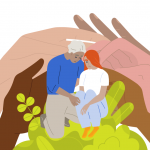Nine Tips for Talking With Kids About Trauma
 As much as we might want to, we can’t always protect children from witnessing violence and tragedy in the world, whether it’s mass shootings, terrorist attacks, or war. As parents, teachers, and other supportive adults, what we can do is comfort and communicate with children in the most healing way possible.
As much as we might want to, we can’t always protect children from witnessing violence and tragedy in the world, whether it’s mass shootings, terrorist attacks, or war. As parents, teachers, and other supportive adults, what we can do is comfort and communicate with children in the most healing way possible.
Below are nine tips distilled from these many resources; more detail and links to others are provided at the bottom of this list.
1. Initiate the conversation
Just because children aren’t talking about a tragedy doesn’t mean they’re not thinking about it, experts say.
To open up the conversation, you might start with questions like these:
- “How do you feel about what’s happening in the world?”
- “What are you or your friends thinking and talking about in terms of the world situation?”
- “Are you and your friends talking about what happened? I’d be really interested in hearing about what you think. Let me know if you want to talk.”
2. Reassure them
Tragedy can rattle our sense of safety, and our children’s. One goal of this conversation is to provide them with the reassurance that:
- Things will get better.
- You will be there for them.
- They can ask you questions anytime.
- They are safe, and so are the people they care about.
To make your reassurances more believable, you can point out some of the safety measures that are being taken, like explaining what security guards do.
3. Listen
Although we always want to be good listeners for our children, it’s especially crucial in the wake of traumatic events.
If children’s fears sound vague or jumbled, parents can help by gently summarizing what they’re hearing: “It sounds like what you’re feeling is…” A few clarifying questions can also help:
- “That’s interesting, can you tell me more about that?”
- “What do you mean by…?”
- “How long have you been feeling…?”
4. Find out what they know
By listening, parents can discover the snippets and rumors that their children have already absorbed about a tragedy. If it’s unclear, a simple “What have you heard about this?” should do the trick.
A key purpose of this conversation is to correct any misconceptions children may have picked up while at the same time offering more concrete information. You can tailor the level of detail depending on their age and how many unanswered questions are weighing on their minds.
5. Encourage children to share their feelings
Sadness, anxiety, fear, stress, even excitement—all feelings are possible in response to tragedy and violence.
We might even encourage children to express their feelings in a non-verbal way, through drawing, writing, singing, or play.
6. Share your feelings
Experts seem to agree that sharing your feelings with your child can be beneficial, with some caveats.
First, you want to communicate that you can handle whatever it is you’re feeling. “[Children] get a chance to see that even though upset, you can pull yourself together and continue on. (If your anger or worries threaten to overwhelm you or distract you from your child, you might not be ready to have this conversation yet.)
7. Focus on the good
Where there is tragedy, there is also heroism—acts by police officers, doctors, or ordinary citizens that restore our faith in humanity right when it is shaken. The forces of good spring into action with their love, support, and generosity. This might include people donating blood, volunteers taking in war refugees, or bystanders who acted courageously in the midst of a violent attack.
8. Encourage children to act
When we feel the pain of others, compassion motivates us to help and to transform that pain into a feeling of connection and support. Encouraging kids to do something about what they’re feeling can give them an outlet and restore their sense of control.
9. Know when to seek outside help
Experts seem to agree that if more than three months have passed and your child is still suffering—from anxiety, distraction, fear, hopelessness, sleep problems, nightmares, sadness, angry outbursts, or headaches—it might be time to consult a mental health professional.
The good news is that kids are very resilient, and they can even inspire us with their feats of strength and optimism.
Excerpted from “Nine Tips for Talking With Kids About Trauma” from Greater Good Magazine. Read the full article online for more details on each of the tips above and additional resources.
Source: Greater Good Magazine | Nine Tips for Talking With Kids About Trauma, https://greatergood.berkeley.edu/article/item/nine_tips_for_talking_to_kids_about_trauma | © 2023 The Greater Good Science Center at the University of California, Berkeley
A screening can help you determine if you or someone you care about should contact a mental health professional. CHC teletherapy services are available now. Call or email our Care Coordinators at 650.688.3625 or careteam@chconline.org to set up a free 30-minute consultation appointment.





